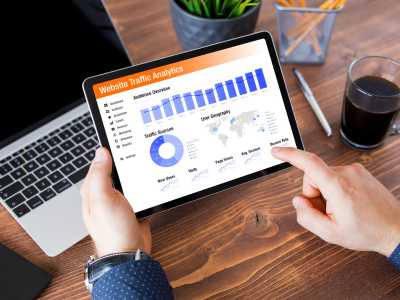We know that Google Analytics 4 Attribution Model is a bit of a mouthful and sounds techy.
But it’s a valuable Analytics function to have and know how to use.
Why? Well, let us take you through a few examples and options so you can decide for yourself.
We’ll show you how to set it all up as well. And if in doubt, please get in touch with our team. We want you to get the best use out of your Google Analytics.
So we’ve got you covered, whether it’s a conversation about which attribution model is best suited for your business or a request to set up Google Analytics for your business.
But first, here are the main points to consider.
Attribution in GA4 – what is it?
Google Analytics 4 (GA4) attribution models are ways to assign credit for a sale or conversion to different touchpoints in the customer journey.
They will provide the data you need to better understand how your content and marketing perform so that you can optimise your web pages and ads.
The default model for GA4 is data-driven attribution, where artificial intelligence (AI) makes the attribution for you and evaluates both converting and non-converting pathways.
However, you can choose other models that allow you to assign the importance of each touchpoint of a customer’s journey as it relates to your business. A different attribution model may better reflect the customer’s decision-making before committing to a purchase or the desired conversion.
In other words, in selecting an attribution model, you determine which marketing efforts were the most influential in a customer’s decision to purchase or take a desired action.
To give you a practical example of the various models, imagine the following scenario: It’s date night, and you’ve decided to go to this new restaurant everyone’s raving about.
You’ve looked at some of the reviews and images beforehand. You booked a table – that was an easy online process. You got there, and the ambience was great, the food was delicious, the cocktails hit the spot, and the service was super friendly. It’s now time to pay the bill.
But who should get the credit for this fantastic date night dinner? The marketing and comms team who created a fantastic campaign? The interior designer who made the place look a million dollars – mood lighting included? The chef who cooked up a storm in the kitchen or the service staff who were friendly and knowledgeable?
You can choose from three types of attribution models with the GA4 properties – in the Attribution reports. Let’s look at what weight these models would give to the various stages of your lovely date-night dinner.
On that note:
There must be foodies working at Google support. Google also chose a restaurant scenario – in Florence, no less – to show the different applications of the various models for Google ads.
Data-driven attribution
This is the default setting in Google Analytics and Google ads. In this model, algorithms do the work in collecting conversion and non-conversion data. This model examines how different touchpoints, time from conversion, device type, and the number of ad interactions impact conversion outcomes and attributes credits to these points based on conversion likelihood.
A data-driven model will therefore be specific to each advertiser and conversion. For our dinner date example, an algorithm will determine the attribution for this one conversion. Should you decide to come back, the attribution may be slightly different again.
The last-click attribution model
This was the default attribution model in Universal Google Analytics and gives all credit for a conversion to the last interaction a user had with the website before a conversion. So how does that translate to your date night dinner?
In a last-click attribution model, the waiter would get all the credit; the chef would be left empty-handed, as would the bartender, the comms and marketing manager, the suppliers, etc.
Ads-preferred rules-based model (last click)
This is a last click-model as well, where 100% of the credit goes to the last Google Ads channel the user clicked through. If no Google Ads exist in a particular customer journey, this model automatically reverts to the Cross-channel last-click one.
So again, the waiter would be the winner of the night.

External attribution
Using a third-party – external – service for your analytics is your third option. It will allow you a custom attribution model and import fractional conversion credits for each click.
What does that mean for date night? You might want to split some of the credit equally between the front of house, the waitress and the bartender, and leave the lion’s share to the chef – who delivered an outstanding meal after all.
A note on Cross-channels rule-based models
Changes are afoot!
If you’re wondering what happened to the first-click, linear and position-based attribution models, Google has announced that they will be retiring. It identified that data-driven attribution is by far the most commonly used model, and Google Analytics will remove these options come June 2023.
When does the attribution apply in GA4 reports?
There’s a lot of confusion with the attribution setting as it only impacts event or conversion-based reporting, along with those dimensions in standard and Explore reports.
User and session-scoped reporting uses last-click attribution. In the acquisition report of Google Analytics 4, the ‘User acquisition’ report uses first-click attribution, while the ‘Traffic acquisition’ report uses the last-click model. There’s no strong indication of this in the dashboard, which is not a great user experience, but hopefully, it will get resolved in the future.
How to set up an attribution model in GA4
This is likely the easiest part of the process. Once you’ve decided on a model that suits your business or measurement goals, the set-up in GA4 is actually straightforward – 5 steps and you’re done:
- Click on Admin in Google Analytics – make sure you’re in the right account and property.
- Click on Attribution Settings in Property.
- Select your attribution model from the drop-down under Reporting Attribution Model.
- Select the lookback windows for Acquisition and All other conversion events under the Lookback window.
- Save
A note on the Lookback Window:The default lookback window for acquisition conversions is 30 days and for all other conversion events it’s 90 days. You can choose different timeframes, depending on how far back you deem a touchpoint eligible for attribution credit.
You may like to choose the window that matches your core marketing funnel e.g. Facebook Ads.
As always, Google also has a comprehensive article on how to select Attribution settings as well.
Are you ready?
We understand Google Analytics can sound like a foreign language for many. But that should not be a hurdle for businesses to make the most of its functions. Far from it, knowing how to use Google Analytics will be an invaluable tool to help your business grow.
Our Business Learn Hub is a comprehensive library of GA4 tips and tricks. And if website analytics is an area that you don’t want to spend too much time on, then we’ve got this.
So don’t let tech jargon get in the way of data-driven decision-making for your business’s success. Get in touch to discuss how we can assist you.













